Event calendar
Experience the excitement of the four seasons!
| January | |||
|---|---|---|---|
| Ebisu Fesetival:9th to 11th | |||
| Sugawara Shrine (TEL 072-232-2450) and other locations |
Ebisu Festival is held in honor of Ebessan, the god of prosperity in business. The festival is also celebrated at Iwatsuta Shrine, Suearata Shrine, Sakurai Shrine, and Hagiwara Shrine. | ||
| "Otondo" or Great Bonfire :15th | |||
| Ebaraji Temple (TEL 072-271-1505) |
Participants offer prayers for good health to a huge bonfire whose flames rise up toward the heavens. Although many temples have bonfires, called tondo, the 5-meter blaze at Ebaraji Temple is particularly large. |
||
 *1
*1
| February | |||
|---|---|---|---|
| Suzu-uranai Ritual:Day before the first day of spring | |||
| Hachita Shrine (TEL 072-271-1355) |
Participants make an offering of 12 bells, one for each year of the Chinese zodiac. Each bell is run as the fortune for that year is read out. | ||
| Sakai Cutlery Festival:Early February | |||
| Southern Osaka Center for the Promotion of Industry | Organized to promote Sakai's cutlery industry, this festival features exhibitors and vendors, design displays, demonstrations of knife manufacturing techniques, and other events. | ||
| Rikyu Memorial:Late February | |||
| Nanshuji Temple (TEL 072-232-1654) |
The "Chasei" tea ceremony is held every year in remembrance of the tea master Sen-no-Rikyu. | ||
| March | |||
|---|---|---|---|
| Spring Festival:21st | |||
| Shorinji Temple (TEL 072-238-2105) |
Held in honor of the god Hakurosu, this annual festival inspired the Kabuki play Tsuritsune. | ||
| April | |||
|---|---|---|---|
| "Hanatsumi"(Flower Picking) Festival:13th | |||
| Otori Shrine (TEL 072-262-0040) |
This traditional and graceful festival adds color to the already brilliant flower season. Today the Hanatsumi ("flower-picking") Maidens carry on a tradition that originated during the Heian period as a ritualistic prayer for good health. |
||
| Sakai City marathon:29th | |||
| Near Daisen Park and Nintoku-ryo tumulus |
Entrants participate in races ranging from 10 kilometers to a full marathon. | ||
| "Tsutsuji-no-Torinuke" or Azalea Blossom Viewingk:Late April to early may | |||
| Asakayama Water Purification Plant | Chosen as one of Osaka's 100 most beautiful natural spots and famous among Sakai residents for its azalea bushes, Aasakayama Water Purification Plant opens to the general public at the end of April. Many visit the plant's grounds to view the beautiful flowers of the gigantic hirado azaleas. |
||
 *2
*2
 *3
*3
| May | |||
|---|---|---|---|
| Sakata Sankichi Memorial Shogi Tournament:3rd Sunday | |||
| Chinugaoka Sports Center | In keeping with its goal of becoming a city known for culture, creativity, and a living history, Sakai sponsors many culture-promoting events. The Sakata Sankichi Memorial Shogi Tournament is part of this program and was organized to commemorate the life of Sakata Sankichi, one of the city's pioneers and a shogi player of remarkable genius. The event attracts amateurs from around the nation. |
||
| Tour of Japan Osaka Stage:Mid May | |||
| Semboku area | The Tour of Japan is a 10-day stage race that starts in Osaka (Sakai). It is the largest national stage race in Asia to be officially recognized by the Union Cycliste Internationale and succeeds the International Cycling Road Race, an annual race that began in 1982 following the passage of the Bicycle Law one year earlier and the concurrent designation of the month of May as Bicycle Month. Originally sponsored by the Bicycle Month Promotion Council, the former Japan Amateur Cycling Federation, and Asahi Shimbun, the race was sanctioned as a national stage race by the UCI in 1996 and was renamed the Tour of Japan. The competition remains Japan's only UCI-sanctioned stage race. *5 *6 |
||
| Hakuo Memorial:29th | |||
| Kakuoji Temple (TEL 072-238-6835) |
Held in memory of the poet Yosano Akiko, this event features readings of her tanka poems and songs. | ||
| "Ajisai-no-Torinuke" or Hydrangea Blossom Viewing:Late May to early June | |||
| Sambo Sewage Treatment Plant | Every year Sakai residents flock to see 1,000 hydrangea in full bloom on the plant's grounds. |
||
 *4
*4
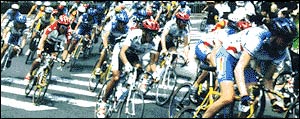 *5
*5
 *7
*7
*6 What is a stage race?
A stage race is a cycling race held over a period of several days as riders travel from city to city, with the series of daily stage races together comprising one complete race. The winner of each day's stage gains the privilege of starting the next day's race, making the event similar to a relay. Another similarity with relay races lies in the fact that the competition occurs among teams. Individual athletes ride for their teams and attempt to ensure that one of team members does well in the race. Unlike relay races, all team members ride at all times, and since the stage race involves a team strategy, the ability of team members to work together effectively plays a large part in determining the winner of the race. Riders must be able to respond to constantly changing race conditions, and team managers must posses the judgment to be able to direct their teams' efforts from outside the race.
| June | |||
|---|---|---|---|
| "Ayame"(Iris) Festival:Mid June | |||
| Otori Shrine (TEL 072-262-0040) |
Visitors enjoy 10,000 irises representing about 50 species. There festival also includes iris offerings and tea ceremonies. | ||
| July | |||
|---|---|---|---|
| Citizen's Noh:Third Saturday | |||
| Civic Auditorium (TEL 072-238-1481) |
Citizens of Sakai perform Noh and kyogen drama at the city's Civic Auditorium. | ||
| Sakai Grand Evening Fish Market:31st | |||
| Ohama Park | Sakai Grand Evening Fish Market recreates a festival originally held in the Kamakura period. Events include a traditional Japanese-style auction and fish sales in a lively atmosphere with merchants with old-fashioned topknot-tied hair and participation by foreigners. |
||
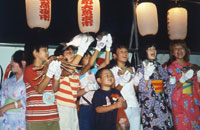 *8
*8
| August | |||
|---|---|---|---|
| Sakai Yukata Festival:Early July | |||
| Undecided | A lively event with many attractions, the Sakai Yukata Festival is organized to promote the city's yukata and Japanese bleaching industries. | ||
| An Evening of Folk Songs:1st, 2nd | |||
| Plaza in front of the Civic Auditorium | Sakai Recreation Association sponsors this traditional folk singing contest. | ||
| Manto-e:15th | |||
| Hounji Temple (TEL 072-361-4419) |
This traditional event is held to pray for good health by lighting lamps and offering them to the spirits of all things. On the evening of Obon (August 15), over 1,000 lanterns representing the prayers of their creators flicker with candlelight, imparting the temple grounds with a surreal beauty. |
||
| Mantokuyo Lantern Memorial Service:16th | |||
| Kanoji Temple (TEL 072-297-2153) |
Numerous lanterns give the temple grounds a fantastic quality. | ||
 *9
*9
| September | |||
|---|---|---|---|
| "Tsukimi" Festival or Moon Viewing Festival (Futon Daiko) :Mid September | |||
Aguchi Shrine |
Futondaiko floats are a famous part of the Sakai region's autumn festivals, when people carry them on their shoulders as they process through town. The five-layered vermillion cushions form a seat for the festival's god and are appropriately vivid in their appearance. In Sakai, the floats are used by many shrines, including Aguchi Shrine, in autumn fall festivals. Mozuhachimangu Shrine in particular is famous for its autumn festival, which is also known as the Tsukimi ("moon-viewing") Festival due to the fact that it is timed to coincide with the harvest moon. During this magnificent and dynamic festival, 17 futondaiko floats of all sizes move in and out of the shrine over the course of two days. |
||
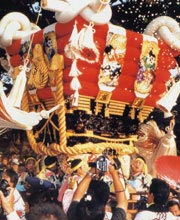 *10
*10
| October | |||
|---|---|---|---|
| Ko-odori:First Sunday | |||
| Sakurai Shrine (TEL 072-297-0043) |
Said to have originated as a rain dance, the Ko-odori festival is held at the Sakurai Shrine and has been designated an Intangible Folk-cultural Property. The humorous dance performed by 17 dancers dressed as demons and long-nosed tengu goblins has been passed down from generation to generation since the Kamakura period. The dance is first presented at the site of the Kuni Shrine, after which it heads toward Sakurai Shrine. The procession of dancers singing religious songs is reminiscent of a fairytale. |
||
| "Danjiri"(Float) Festival:Early to mid October | |||
| Otori Shrine Kusabe Shrine Nonomiya Shrine Tajihayahime Shrine Mitami Shrine Sakurai Shrine Ishizu Shrine Suearata Shrine Tsukuo Shrine Hishiki Shrine Harata Shrine Hagiwara Shrine etc |
Along with the Futondaiko Festival, the Danjiri Festival is typical of the Sakai region's autumn festivals. Rolling danjiri carts are pulled through the streets in a lively festival overflowing with energy and vigor that is famously unique to the Senshu area. In Sakai, individual neighborhoods maintain over 80 danjiri carts and take great pride in the festival's rich historical traditions. In October of each year, the festival begins at Otori Shrine and continues at the autumn festivals of numerous shrines. |
||
| Sakai Citizens' Olympics:Second Monday(Health and Sports Day) | |||
| Kanaoka Park etc |
The Sakai Municipal Olympics is held every year on Health and Sports Day. Since they were first held in 1975, the games have become one of Sakai's Big Three festivals along with the Sakai Festival and the Sakai Agricultural Festival. The Sakai Municipal Olympics pits athletes from each of the city's 90 elementary school districts against one another in a variety of competitive sports. *13 *14 |
||
| Sakai Festival:Third Sunday and preceding day | |||
| Oshoji Symbol Road Xavier Park etc |
The Sakai Festival has highlighted the city's proud traditions during the two days ending on the third Sunday of October every year since 1974. The festival features a variety of events held along the Oshoji Symbol Road leading to the town center and in Xavier Park at the site of the medieval merchant Hibiya Ryokei. Central to the festival is an enormous and elaborately staged parade featuring a total of 12,000 participants that includes the city's distinctive "Nanbanbune" floats, performances by groups of brave soldiers wielding matchlock guns, and processions of folk costumes from around the world. Typically attracting more than 600,000 attendees, the event captures Sakai's uniquely historic and international flavor with attractions such as the "Nanban Market," where visitors can purchase local specialties. |
||
| Grand Tea Ceremony:Third Sunday and preceding day | |||
| Daisen Park |
|
||
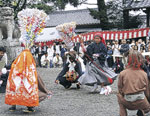 *11
*11
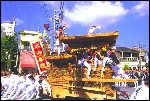 *12
*12
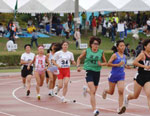 *13
*13
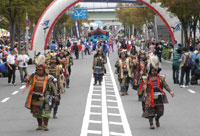 *15
*15
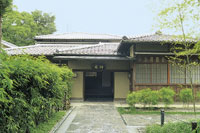 *16
*16
| 1 | Softball | Men 25 and over |
|---|---|---|
| 2 | Volleyball | Women 25 and over |
| 3 | Table tennis | Men/women 15 and over |
| 4 | Track 100-meter 3,000-meter 5,000-meter 400-meter Running long jump |
Men/women, elementary age and up |
| 5 | Gateball | Men/women 55 and over |
| 6 | Tug of war | Men/women 20 and over |
Information: Sports Promotion Section TEL 072-228-7437
| November | |||
|---|---|---|---|
| Sakai City Agricultural Festival:23rd (Labor Thanksgiving Day) | |||
| Daisen Park | The Sakai Agricultural Festival features the "Tore-tore Market," where visitors can purchase fresh locally grown fruits and vegetables; judging contests for produce and livestock; a flower and plant market; a local specialties market; and a playground for children. Sponsor: Sakai Agricultural Festival Steering Council Information: Farm and Fisheries Section of the Sakai City Economic Bureau Agricultural Administration (TEL: 072-228-6971; FAX: 072-228-7370) |
||
 *17
*17
| December | |||
|---|---|---|---|
| Yassaihossai:14th | |||
| Iwatsuta Shrine (TEL 072-241-5640) |
Yassaihossai consists of a ritual where 108 bundles of charcoal are burned in front of the shrine's altar as people walk across the resulting fire. It is said that bringing home a charcoal ember confers protection against evil spirits. |
||
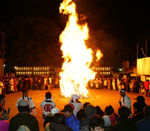 *18
*18
